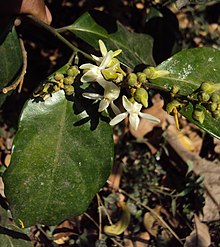Xanthophyllum beccarianum is a tree in the family Polygalaceae. It is named for the Italian botanist Odoardo Beccari.
Xanthophyllum ceraceifolium is a tree in the family Polygalaceae. The specific epithet ceraceifolium means "waxy leaf", referring to the appearance of the leaves.
Xanthophyllum clovis is a tree in the family Polygalaceae. The specific epithet clovis is from the French meaning "nail" or "clove", referring to the clove-like appearance of the buds.
Xanthophyllum ellipticum is a plant in the family Polygalaceae. The specific epithet ellipticum is from the Latin meaning "elliptical", referring to the leaves.
Xanthophyllum flavescens is a plant in the family Polygalaceae. The specific epithet flavescens is from the Latin meaning "becoming yellow", referring to the leaves.
Xanthophyllum impressum is a tree in the family Polygalaceae. The specific epithet impressum is from the Latin meaning "impressed", referring to the enclosed position of the axillary buds.
Xanthophyllum lineare is a tree in the family Polygalaceae. The specific epithet lineare is from the Latin meaning "line", referring to the linear shape of the leaves.
Xanthophyllum neglectum is a tree in the family Polygalaceae. The specific epithet neglectum is from the Latin meaning "neglected", referring to how the species has been long overlooked.
Xanthophyllum obscurum is a tree in the family Polygalaceae. The specific epithet obscurum is from the Latin meaning "dark", referring to the dark colour of the dried flowers and fruits.
Xanthophyllum pauciflorum is a tree in the family Polygalaceae. The specific epithet pauciflorum is from the Latin meaning "few flowers", referring to the inflorescences.
Xanthophyllum pedicellatum is a plant in the family Polygalaceae. The specific epithet pedicellatum is from the Latin, referring to the long pedicel.
Xanthophyllum pseudoadenotus is a plant in the family Polygalaceae. The specific epithet pseudoadenotus is from the Greek, referring to the plant's resemblance to X. adenotus.
Xanthophyllum ramiflorum is a plant in the family Polygalaceae. The specific epithet ramiflorum is from the Latin meaning "flowering on the branches".
Xanthophyllum reflexum is a tree in the family Polygalaceae. The specific epithet reflexum is from the Latin meaning "bent backwards", referring to the flower petals.
Xanthophyllum reticulatum is a plant in the family Polygalaceae. The specific epithet reticulatum is from the Latin meaning "netted", referring to the leaf veins.
Xanthophyllum stipitatum is a plant in the family Polygalaceae. The specific epithet stipitatum is from the Latin meaning "stalked", referring to the ovary of the flower.
Xanthophyllum subcoriaceum is a plant in the family Polygalaceae. The specific epithet subcoriaceum is from the Latin meaning "somewhat leathery", referring to the leaves.
Xanthophyllum tardicrescens is a tree in the family Polygalaceae. The specific epithet tardicrescens is from the Latin meaning "slowly growing", referring to the twigs.
Xanthophyllum tenue is a tree in the family Polygalaceae. The specific epithet tenue is from the Latin meaning "slender", referring to the twigs.
Xanthophyllum trichocladum is a plant in the family Polygalaceae. The specific epithet trichocladum is from the Greek meaning "hairy twig".
